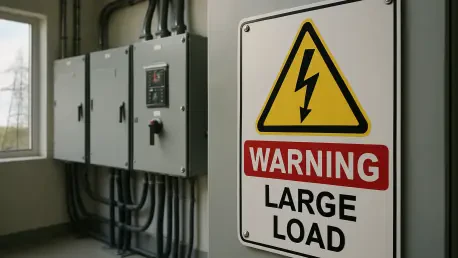In a world where data centers and manufacturing giants devour electricity at an unprecedented rate, states are scrambling to keep the lights on without burdening everyday consumers. Picture a sprawling data hub powering the cloud and artificial intelligence, consuming as much energy as a small city, and you’ll understand the pressing reality driving Kansas and Michigan to roll out groundbreaking regulations for large energy loads. With grid stability and cost fairness hanging in the balance, these states are setting a precedent that could reshape how America handles its soaring energy demands.
Why Large Load Energy Rules Are a Hot Topic
The surge in energy consumption by industries like data centers and semiconductor plants has thrust large load regulations into the spotlight. These facilities, essential for cloud computing and AI advancements, are placing massive pressure on utility grids, often requiring gigawatts of power to operate. Kansas and Michigan, recognizing the urgency, have stepped up with innovative policies to manage this demand, ensuring that the infrastructure can keep pace with technological growth.
This issue transcends local boundaries, reflecting a national challenge as digital infrastructure expands rapidly. The stakes are high: without proper oversight, the grid could falter, leading to outages or skyrocketing costs for residential users. Both states are pioneering solutions to this modern dilemma, capturing attention as models for balancing industrial needs with public welfare.
The High Stakes of Integrating Massive Energy Loads
Managing large energy loads is critical to sustaining economic momentum while protecting utility customers from unintended consequences. Unchecked growth in energy-intensive sectors risks overloading grids, potentially causing blackouts or forcing utilities to raise rates for everyone. This tension between fostering industry and safeguarding reliability is at the heart of the regulatory push in Kansas and Michigan.
Beyond immediate grid concerns, the issue ties into broader trends like the digital revolution and the shift toward sustainable energy. As data centers multiply to support global connectivity, states must ensure that economic benefits, such as job creation, do not come at the expense of environmental goals or consumer budgets. These regulations aim to strike that delicate balance, addressing both present risks and future aspirations.
Inside the New Frameworks for Kansas and Michigan
Regulators in Kansas and Michigan have crafted detailed rules to govern how utilities like Evergy and Consumers Energy handle large load customers. In Kansas, Evergy’s plan, approved by the Kansas Corporation Commission, targets facilities exceeding 75 MW, requiring 12-year service agreements and minimum usage payments of 80% of contracted demand. A unique feature offers four clean energy access options, aligning with sustainability goals, while a five-year ramp-up period allows new facilities to scale operations gradually.
Michigan’s approach, overseen by the Michigan Public Service Commission for Consumers Energy, applies to loads over 100 MW with a 15-year contract commitment and similar 80% minimum payment terms. A comparable ramp-up window of up to five years is included, but the state emphasizes strict financial transparency to prevent cross-subsidization. With Evergy managing a 15 GW demand pipeline and Consumers Energy handling 9 GW, these policies underscore the massive scale and urgency of adapting to industrial energy needs.
Stakeholder Voices Weigh In on the Impact
Insights from key players reveal the complexity and significance of these new regulations. A spokesperson from the Kansas Corporation Commission emphasized, “These rules ensure that large load customers bear the cost of grid upgrades, protecting residential ratepayers from unfair burdens.” This sentiment reflects a core priority of shielding existing users from the financial fallout of industrial expansion.
Utility representatives and energy analysts also highlight broader implications. A Consumers Energy official noted the importance of long-term contracts in preventing stranded assets, while a national energy consultant pointed out that these state actions align with federal discussions at the Federal Energy Regulatory Commission (FERC), which is exploring nationwide large load interconnection rules. Such perspectives place Kansas and Michigan’s efforts within a larger grid management dialogue, illustrating their potential to influence policy on a grander scale.
Charting the Path Forward for Energy Stakeholders
For businesses, policymakers, and utilities navigating this evolving landscape, practical strategies are essential to align with the new rules. Large load customers must prioritize securing long-term contracts and budgeting for infrastructure costs to meet minimum usage requirements. Planning ahead for the five-year ramp-up period can also ease the transition, ensuring operational stability while complying with state mandates.
Smaller utilities and other states can draw lessons from these frameworks by focusing on cost fairness and grid reliability. Adopting similar policies might involve tailoring contract lengths or clean energy incentives to local needs, as seen in Kansas. Balancing economic growth with environmental objectives remains crucial, requiring stakeholders to integrate renewable energy options wherever feasible to meet both industrial and sustainability targets.
Reflecting on a Pivotal Moment in Energy Policy
Looking back, the bold steps taken by Kansas and Michigan marked a turning point in addressing the challenges of massive energy demands. Their regulations set a foundation for managing large loads without compromising grid stability or burdening everyday consumers. As other states and federal bodies observed these outcomes, the focus shifted to adapting and scaling such solutions. Moving forward, stakeholders were encouraged to collaborate on refining these frameworks, ensuring that innovation in digital and industrial sectors continued to thrive alongside fair and sustainable energy practices.









